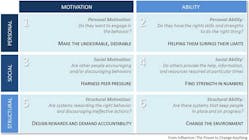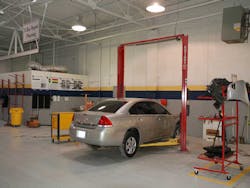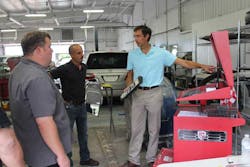Recently I was contacted by the owner of collision repair shop that was attempting to implement a repair planning department at their shop. The owner, we’ll call him Frank, was clearly beyond frustrated. I listened intently for nearly an hour as he explained his experiences over the last several months while implementing the new program. He and several members of his leadership team had been to formal lean and blueprint training, and I was impressed with the depth of Frank’s knowledge about the process.
I said, “Well Frank, it sounds like you have it all figured out, so how can I help you?” In an exasperated tone, he replied, “None of it is working!”
Frank explained that there are more missed parts on the estimates than ever before, he was getting a lot of push back and complaints from the body techs and morale is at an all time low. Furthermore, several people were threatening to quit because they didn’t like all the changes taking place. Frank understandably felt like he was in over his head and was ready to give up.
I agreed to work with him and set up a day to come visit his shop.
Frank’s problem, as it is with so many other leaders in business and in life, was that despite being very well educated in the collision repair business, he was lacking the modern leadership and influence skills necessary to be successful when implementing such radical change. You see, Frank had grown up in the industry and was taught how to manage people and processes by his father many years ago. Despite being a decent person, unfortunately, Frank was more of a ruler than a leader.
The six sources of influence
Like Frank, most of us learn only one method of getting people to do what we want them to do. This one source is our mouth. The mouth is actually a very effective influence tool for the easy stuff. All we have to do is tell the person what we want them to do, right? The problem is that for pervasive problems and radical change — initiatives such as a blueprinting, a.k.a. the repair planning department — the mouth rarely works! If you want to be a successful implementer, you are going to need to learn to use six sources of influence instead of only one. The six sources were introduced to me in a book called Influencer by authors and behavioral scientists Grenny, Patterson, Maxfield, McMillan, and Switzler. I recommend you give it a read some time.
When it comes right down to it, we usually all want the same things. We may have opposing views of how to achieve it, but when it comes to the final result of the change initiative, we usually all agree. The problem, when it comes to ordinary verbal persuasion methods, is that the whole time we are talking and forming arguments, the resistant audience is not really listening to you, because they are busy unconsciously forming their own counter arguments. When you say, “Hey guys, I figured out a way we can streamline our processes and make more money doing it!” They instead hear, “Hey indentured servant, I have figured out how to make you do a bunch of extra free stuff in another weak attempt to make the owner rich!”
When people create an implementation plan that engages at least four of the six sources of influence, you are almost guaranteed a favorable outcome. Even if you don’t create a formal implementation plan, it really helps to understand the forces that are working for you and also against you.
Source one: Personal motivation
How do you get people to love what they currently hate or perceive they will hate doing? Most of the time, we use verbal persuasion as a means of changing someone’s mind, but as I mentioned a moment ago, you may need to engage other forces if you want to reach someone’s intrinsic motivation and help them enjoy the activity. One method I like to use to accomplish this is to attempt to get the person or team that is resisting the activity to try it. Often things aren’t as bad as they thought! Another technique is to make mundane tasks into a game. Things are much more fun when you get to keep score. Think of the social media game “Candy Crush.” Do you think millions of people would waste their time playing that game if there was no scoreboard?
Source two: Personal ability
Great implementers will always provide lots of training. Nobody likes to admit to you that they don’t understand what it is you are asking them to do. Do everyone a favor and over invest in training to ensure they have all the skills necessary to perform the vital behaviors required to make your process a success.
Source three: Social motivation
Probably the most powerful source that is working for you or against you is the social “culture” that exists in your business. A leader who has a vision and shares it with the team stands the best chance of winning. I like to engage the team to help create the processes that will be implemented. People want to feel like they are contributing toward the vision, not just showing up for a paycheck.
Source four: Social ability
Invest in providing training for your team, not just technical skills, but also social skills. Giving the team the interpersonal skills to help one another and also hold one another accountable in a safe way will go a long way toward implementing anything.
Source five: Structural motivation
I believe the best way to provide structural motivation begins with everyone working toward a known standard. When vital behaviors and standards are met, you have to reward people! Often praise is enough. Sometimes money is an appropriate structural motivator, but never as a replacement for correctly providing a good social structure first. In other words, if you are not skilled as a leader, throwing money at people in hopes of keeping them motivated usually doesn’t work for long. In fact, it usually backfires!
Source six: Structural ability
People rarely think about how their environment affects behaviors. The things that are around us all day, every day can have a huge impact on our lives. Things like how the shop is laid out, how far people have to walk to get things, etc. For example, if you were trying to abide by your diet, would you want to place a box of donuts on your desk? Probably not. Occasionally take look at your environment like it was the first time you walked into the building. You might be surprised how “things” are keeping us from being successful. If you want vital behaviors enacted, you must make it easy for people to accomplish them.
Upon meeting with Frank and his team, it became apparent quickly that they had put a lot of work into their new blueprinting department. They purchased parts carts, painted lines on the floor, and had even placed new signage above their new “Repair Planning Department.” Everything on the surface looked great, but as is often the case, when you pull back the curtain, the problems become exposed!
Working with Frank, we interviewed everyone working at the shop and were soon able to discover the root cause of most of the problems. Usually what I find while working with shops is that employees are bombarded with symptomatic problems that are caused by only a small handful of root problems. Typically, these root problems are a result of critical process steps being skipped. In Frank’s case, most of the missed parts and wrong parts that were discovered during vehicle reassembly were a result of two vital behaviors being performed poorly and inconsistently far upstream: 1) sequenced analysis of the damage and 2) mirror-matching parts.
We discovered that the employee who was analyzing most of the damage out in the shop as the “repair planner” was also the shop’s production manager. This guy was constantly being interrupted and pulled off his job of repair planning, and when he would get back to repair planning, he would forget where he left off, thereby leaving off necessary parts and labor from his estimates.
The shop did have a parts guy who was supposed to be opening new parts boxes and checking them against the old damaged part for correctness, but he had long ago given up on the idea. It turns out most of the time, he couldn’t even find the old parts to compare them to.
Because of these problems, the technicians in the shop also felt like the whole repair planning department idea was a joke.
By the end of my visit with Frank and his team, we had created a written action plan using all six of the sources of influence. We spent precious time working with the technicians to ask for their input and support. We got agreements to assist the repair planner and the parts managers and encourage good decision-making during those critical moments when the pressure of the real world causes many to skip critical steps. We implemented a better system for organizing the old, damaged parts so that they would be easy to locate during mirror matching.
In the months since introducing the written six-source implementation plan, things have been much better for Frank. By understanding that true leadership is much more than barking out commands, Frank has learned and embraced many new ways of connecting with his team in a highly effective way. He also mentioned that his new skills have helped him in many other facets of his life, and he is excited to continue his leadership education.





